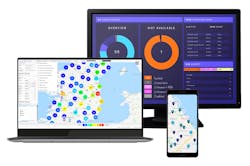Driivz, Rhythmos integration aims to optimize charging schedules, avoid peak demand costs
A big question in regards to how quickly fleets can adopt electric vehicles comes down to whether the local utility can support the excess demand. The onus to power dozens of Class 8 trucks shifts from fuel stations to power plants, and that new load comes at a cost.
“Electric fleets require a substantial and sustained amount of energy, so ensuring utilities can provide adequate electricity to meet fleet owners' demands will continue to be a long-term challenge,” Rhythmos CEO Ken Munson told Fleet Maintenance.
To ease this challenge for both utilities and fleets, Rhythmos, which provides software solutions designed by utility veterans to optimize electric mobility, has partnered with Driivz, which offers a cloud-based platform to manage EV chargers for tens of thousands of existing charging points globally, to optimize EV charging schedules. This could potentially double charging capacity.
"For a typical utility using our platform, we estimate that EV penetrations can double, or more, compared to unmanaged or time-of-use based EV charging without upgrades and associated expense," Munson noted.
Read more: Fleets 'frustrated' with utilities slow to support electric truck charging
He explained that the Driivz platform “will orchestrate on-site charging of EV fleet vehicles consistent with the needs of the fleet operator and within the constraints of the utility infrastructure. This guarantees fleets receive the electricity necessary while not putting additional strain on utilities.”
Because electric vehicles require a higher upfront cost versus a diesel- or gas-powered vehicle, fleets will have to recoup their investment through overall total cost of ownership. That becomes harder if a fleet is always charging at peak times, when electricity costs are highest.
“Costs to fleets to recharge vehicles will be comprised of utility demand and energy charges,” Munson said. “If fleets are not considering how and when to charge EVs, they could be setting themselves up to set higher peak demand for their facilities and greatly increasing their demand charges. And, if they charge in the afternoon and early evening, they could be exposing themselves to higher energy price periods.”
The Rhythmos algorithm was designed to optimize charging time and avoid peak demand and lower energy costs, “while still ensuring the fleet’s vehicles are ready for duty in the morning,” Munson explained.
Interested in learning more about how the energy and transportation industries are preparing the grid for electrification? Check out T&D World Live (Sept. 12-14 in Sacramento).
Major benefits for customers employing the integrated solution include “avoiding network congestion, maximizing the use of clean electricity, and lowering charging costs,” noted Doron Frenkel, founder and CEO of Driivz.
According to Driivz, its platform manages hundreds of millions of EV transactions and repairs up to 80% of operations issues remotely. The company supports over 750 charger models and is certified for the EV communication standard OCPP 2.0.1.
“Our progressive solution for EV charging and energy management combined with Rhythmos’ utility expertise and technology is critical for the industry as high-volume EV charging soars,” Frenkel added.
How it works
According to Munson, the fleet sets its default operational requirements on the Rhythmos fleet dashboard for when the vehicles need to be fully charged in the morning. Then the Rhythmos platform generates a daily charge schedule based upon that default, as well as the updated vehicle state of charge provided by the fleet or through ISO 15118/OCPP 2.0 compliant chargers via the Driivz platform.
Next, the Driivz platform executes the optimized charge schedule. If an operational need pops up that night, fleet operators have the ability to opt-out of a managed charging schedule.
“For fleets that choose less than one-to-one chargers to vehicle, these fleets will need to have staff to shuffle vehicles through the two chargers to meet their needs,” Munson added. “These situations do not lend themselves to optimized charging because there will be little to no demand flexibility in charging loads.”
The partnership will first target utilities in California, where EV adoption is currently the strongest.
“In the future, both utility providers and fleet owners will be able to inquire about adopting these platforms,” Munson said.
About the Author

John Hitch
Editor-in-chief, Fleet Maintenance
John Hitch is the award-winning editor-in-chief of Fleet Maintenance, where his mission is to provide maintenance leaders and technicians with the the latest information on tools, strategies, and best practices to keep their fleets' commercial vehicles moving.
He is based out of Cleveland, Ohio, and has worked in the B2B journalism space for more than a decade. Hitch was previously senior editor for FleetOwner and before that was technology editor for IndustryWeek and and managing editor of New Equipment Digest.
Hitch graduated from Kent State University and was editor of the student magazine The Burr in 2009.
The former sonar technician served honorably aboard the fast-attack submarine USS Oklahoma City (SSN-723), where he participated in counter-drug ops, an under-ice expedition, and other missions he's not allowed to talk about for several more decades.

